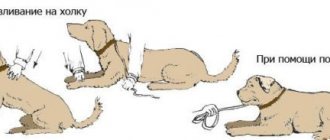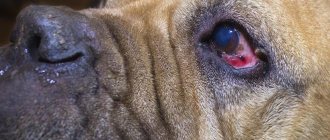Territories
One of the main questions that researchers have been asking is information about where and when exactly the domestication of the dog occurred. Most scientists come to the conclusion that this happened about 25 thousand years ago, that is, long before man mastered agriculture. The domestication of the dog was an important stage in the history of the human race, since this particular animal species was the first to be domesticated. Moreover, it is quite obvious that this happened on the Eurasian continent. However, researchers have been searching for the exact place where the animal was domesticated for many years.
Understanding in what century the process of domesticating dogs began, we can come to the conclusion that this happened around the 15th century BC.
The results of recent research have demonstrated that dogs originated from not one, but two completely different populations of ancient wolves. In addition, it turned out that the double domestication of dogs occurred at opposite ends of the Eurasian continent.
Dogs are like people
A re-analysis (Losey and his colleagues, 2011) of dog burials dating back to the Late Mesolithic - Early Neolithic period of the Chinese Baikal region suggests that in some cases dogs were awarded a “badge of distinction” and equated to humans.
The dog burial at the Shamanaka site consisted of a middle-aged cable (probably a husky). The burial is dated to approximately 6200 BC. The dog was buried in a human cemetery in a similar manner. Losey and his colleagues believe the dog may have lived with its human family in Shamanaka.
The burial of an adult wolf was also found at the Lokomotiv-Raysovet cemetery. Tests showed that his diet was based on ungulate meat, but there was no evidence that he was part of human society. However, he was also buried with all formalities.
These burials are exceptions, but not so rare - there are others. But there is also evidence that people of the Kitoi culture (late Mesolithic fisher-hunters on Lake Baikal) buried dogs and wolves. As Losey and colleagues suggest, this indicates that Quitoan hunter-gatherers considered at least these individual dogs to be equal to humans.
Where to look for the solution?
Until relatively recently, some researchers believed that the very first domestic dogs appeared in Europe, while others - in Asia. The situation was significantly complicated by various archaeological studies, which indicated that ancient dogs had already settled on both sides of the Eurasian continent many millennia ago.
Recent research into the history of dog domestication suggests that both sides are right.
By comparing genetic data with archaeological research, an international team of scientists concluded that dogs originated from two completely different populations of wolves. More precisely, already extinct animals that are considered the ancestors of not only modern dogs, but also modern wolves. Therefore, most likely, the domestication of dogs by humans took place twice in different parts of the mainland.
These studies were led by representatives of the University of Oxford. They found that these populations of wolves lived in the west and east of Eurasia, being in no way connected with each other.
Based on this, we can conclude that the domestication of dogs by humans occurred in the Paleolithic era. The discovery was made by two groups of people independently of each other. At about the same time, they came to the conclusion that these useful and intelligent four-legged animals could be tamed and bred so that they could live next to a person and help him in everything.
When exactly were dogs domesticated?
Contents hide
About a year has passed since the publication of the publication devoted to the problems of the relationship between man and dog. This article was also posted on our Zen channel and caused a number of comments, some of a sarcastic nature. Thus, one of the commentators, having read that dogs, according to some scientific data, were domesticated approximately 40,000 years ago, sent the author-translator to study at school. By the way, it would be nice to return to those times! But the question itself somehow hung in the air: has the friendship between man and dog really lasted since such time immemorial? We invite you to read a new article on the topic.
Debates in the scientific world. Traditionally, in short: scientists around the world have expressed various hypotheses on this matter, but have not yet come to a consensus. One thing is clear: the dog was the first animal to be domesticated by man. Another, no less important answer remained unanswered. Who are modern dogs? Is this a separate species that evolved in its own way, or did man attract and domesticate the most friendly gray wolves? To this day we have not received any clear answer from science.
When did dogs become pets? Different sources provide different data. So, here and there there is information that the process of domesticating dogs began as much as 130,000 years ago. Other sources give a more conservative figure: 15,000 years ago. The figure of 40,000 years ago in the media with the light hand of scientists from Smithsonian University (USA). This figure is not taken out of thin air. Scientists have conducted genetic studies of Neolithic fossils of ancient dogs dating back to this time. The analysis showed that ancient dogs were generally similar to their modern counterparts. But scientists suggested that there were several waves (stages) of domestication over thousands of years, and not all attempts were crowned with success. The DNA of those dogs is, of course, very similar to the DNA of modern dogs, but we still can’t talk about 100% similarity. It is assumed that the second stage of domestication, undertaken in Europe and East Asia approximately 14,000-15,000 years ago, was more successful.
Where did the primitive dog come from? We will operate with documented, 100% verified scientific data. Our pets are most likely descendants of European domesticated dogs. Evidence based on the DNA of a dog fossil (approximately 14,000 years old) discovered in what is now Germany. But we talked above not only about Europe, but also about East Asia. It is assumed that the domestication of dogs began simultaneously in different parts of the world, with Asia probably beginning the process even earlier. Some scientists even recognize Southern China as the birthplace of modern dogs.
What do wolves have to do with it? Why did a person come up with the idea of domesticating a dog? And what do wolves have to do with this? For now we can only guess. To this day, the theory that people did domesticate gray forest predators has not been refuted. How did they do it? Scientists are divided into several camps. The first claim that people took in wolf cubs, raised them, tamed them, instilled good manners and gradually domesticated them. But one question hangs in the air: how did people approach wolves and take away their offspring, because it is common knowledge that grays are ready to protect their cubs to the last drop of blood.
Other scientists claim that wolves have become “self-domesticated” to some extent. That is, the most friendly and sociable predators approached human habitation, received handouts, which they fed on. Then, at a certain stage, they came to the understanding that they could stay with the person and work “for food” - that is, on a mutually beneficial basis. That is: wolves took upon themselves the protection of the homes of our ancestors, were responsible for security, and then helped in the hunt. Accordingly, people provided warmth (fire), a roof over their heads, food and general protection.
Experts at the Smithsonian Institution pay tribute to the theory of evolution. They believe that friendship with humans over time even caused physical changes in the appearance of wolves. As they say, you don’t have to look far for examples. Many experiments on taming wolves have been and are being carried out. Not everything ended in success. But still, after several generations, “domestic” wolves acquired a slightly different appearance compared to their wild counterparts. The article, in particular, talks about an experiment with the domestication of foxes (it was carried out in Russia). Scientists selected foxes and tried to tame them. Gradually the results came: the least aggressive foxes began to recognize their “masters”, took food from their hands, learned commands, and finally lost their sense of fear towards people. In other words, the results were not red-haired pranksters, but real dogs.
All these experiments, in our opinion, convincingly prove that the true ancestors of modern dogs are wolves. The process of domestication was very difficult, it lasted for millennia, and yet evolution had its weighty say: the least aggressive and at the same time the most social animals joined people. They gave birth to offspring, and the process continued to grow.
As for DNA, wolf DNA is 98.8% similar to dog DNA. Both of them are school animals and form communities with a pronounced hierarchy. Both of them mark the territory, defend it, look for a den for refuge, lick those they obey or whose attention they want to attract, etc. Finally, wolves, like dogs, vary greatly in temperament and personality. Indeed, there are individuals that are a little more “friendly” towards humans.
However, modern science does not consider the wolf and the dog to be the same species. Wolves are classified as canis lupus, and dogs are classified as canis familiaris. Wolves are large, smart, strong and resilient. They cover enormous distances per day. Even an uninitiated person can easily distinguish the merciless gaze of a wolf from the gaze of a dog. Finally, wolves often use howling as a means of communication. Dogs can also howl, but they do it less willingly.
Conclusion. As you can see, there is no definite answer to the question posed in the title. The spread, you see, is very large: 15,000 or 130,000 years is too big a difference. Perhaps we will never know the whole truth about the domestication of dogs. But let’s all say “thank you” to the dogs for having them!
Original publication : When Did Dogs Become Pets? Author : Krissy Howard. Source : cuteness.com Photo : antimrakobes.mirtesen.ru ( from open sources ).
Decoding the genome
An important step in resolving the issue of domestication was the findings discovered in a Neolithic corridor tomb in Ireland called Newgrange. Here archaeologists found the remains of an ancient small dog. Its age was about 4,800 years. DNA was extracted from these remains for further research.
The authors of this work from Trinity College Ireland noted that it was from the remains of this dog that they were able to extract DNA, which became the most informative of all those currently preserved. Thanks to her, it was possible to obtain a prehistoric genome of rare quality.
* * *
Let's say wolves domesticated themselves, but when exactly did they decide to do this?
A group of geneticists led by Peter Savolainen, having examined the DNA of modern dogs, confidently breeds them from southern Chinese wolves that lived no later than 16,400 years ago. This region still has the widest genetic diversity in dogs. According to this scheme, dingoes are considered the oldest domestic dogs, followed by African Basenjis and Arctic husky dogs. Supporters of this version, citing dating, see domestication as one of the stages in the transition from hunting to agriculture and consider the first domestic dogs to be a meat breed of livestock. True, feeding a domesticated wolf, unlike a dog, requires 1-2.5 kilograms of fresh meat per day - that is, even a one-year-old wolf gives much less meat than it takes to feed it.
At the same time, a group of archaeologists and geneticists led by Robert Wayne consider the wolf to be “European.” Animal skulls from the Robber Cave in Altai are confidently dated to the 31st millennium BC, and finds in Goya (Belgium) to the 34th. The search for kinship not by nuclear, but by mitochondrial DNA, transmitted through the maternal line, led Wayne's group to the conclusion that the genes of modern dogs contain traces of similar creatures that lived more than 30 thousand years ago, whose closest wild relatives are European wolves.
Skull of a Paleolithic “dog” from Goye Cave (Belgium)
Skull of a dog from the Robber Cave (Altai)
Another purpose of the dog naturally follows from the earlier dating - domesticated by Paleolithic hunters, it was hardly considered by them as a supply of meat. Rather, ancient people were interested in the extraordinary sense of smell of former wolves or the guarding and transportation by dogs of many tons of harvested mammoth meat, without draft animals, unsustainable for small human groups.
Of course, supporters of the point of view of the late (Neolithic) domestication of dogs look for shortcomings in the conclusions of ideological opponents. And they find it - a February publication by the Abby Drake group claims that the find from the Belgian Goye Cave is closer in skull structure to a wolf than to a dog. On the basis of which it is argued that domestication occurred only in the Neolithic - at the same time as the domestication of other domestic animals.
Unfortunately, Drake's work ignores a study by Russian scientists published in 2011 that clearly points to the existence of a canine skull that is 33-34 thousand years old. Moreover, as the lead author of that work, Yaroslav Kuzmin, noted, the skull from the Altai Robber Cave is extremely similar to the remains of a dog from Greenland that lived only a thousand years ago. This means that already 33 thousand years ago, the domestication of canines had advanced extremely far - almost to the modern level!
The question of the time of domestication was finally clarified after the publication of a work in 2013, the first author of which was listed as geneticist Anna Druzhkova from the Institute of Molecular and Cellular Biology of the Siberian Branch of the Russian Academy of Sciences. Analysis of 413 nucleotides of the Paleolithic Altai dog showed that it is significantly closer to dogs and prehistoric canines of the New World than to modern wolves. Accordingly, the animal from the Robber Cave, 33 thousand years old, is the oldest dog known today, which means that the domestication of our smaller brothers occurred long before the advent of agriculture. The same Yaroslav Kuzmin believes that it is not even clear yet who the owners of the first Altai dog were: “both Cro-Magnons and Neanderthals are suitable in age.” In other words, the first domestication, in principle, may turn out to be pre-human.
Human and dog skeletons discovered in the ruins of a 12,000-year-old house in Galilee
Here, dog lovers can breathe a sigh of relief: almost all researchers believe that the domestication of dogs in the Paleolithic could not have been aimed at slaughtering them for meat. Man at that time was so well supplied with big game meat that he now disdained delicious venison, feeding it to his pets.
Comparative analysis
Further work was carried out jointly with the staff of the National Museum of Natural History in Paris. Mitochondrial DNA was analyzed and collected from the remains of 59 ancient dogs that lived from 3 to 14 thousand years ago. The genetic signatures of this animal, including the signature of the same dog from Newgrange, were compared with each other and with previously studied genomes of another two and a half thousand modern dogs.
Scientists noted that reconstructing the past using modern DNA is the most accurate method of research, which can be roughly compared to reading a history textbook. But at the same time, as when reading a textbook, you can never know in detail what information, possibly important, was irretrievably lost or omitted. A completely different situation arises when you have ancient DNA on your hands. In this case, the situation is more reminiscent of the opportunity to use a time machine, which allows the researcher to study the past by literally observing it with his own eyes.
Versions of domestication of dog ancestors
Numerous crossings of dogs and wolves, mixing their genes, also cause confusion. Such cases occur in the modern world. Although dogs today protect livestock and humans from wolves, such interspecies relationships do occasionally occur. The intrigue lies in when and why the hunter became friends with the wolf. In an old fairy tale, a man became a friend to a wounded wolf. But scientists reject this literary version.
Some of them believe that ancient people somehow caught wolf puppies and gradually tamed them. This was around the time agriculture began about 10,000 years ago. The oldest dog remains are approximately 14,000 years old. But there are also older remains that claim to be the ancestors of modern dogs, not wolves. Therefore, other scientists believe that domestication occurred much earlier.
They support the version that only the friendliest wolves survived near humans, leaving hunter-gatherers alone. It was incredible that a large predator, competing with man for food, became his faithful assistant and friend.
Physical changes gradually occurred in wolves, which led to the formation of the appearance of dogs. They developed rough fur, curly tails and floppy ears. Apparently, individuals friendly to humans had such physical abnormalities. Similar experiments were carried out in Russia with foxes. These foxes were friendly and followed commands well. The appearance of these foxes increasingly resembled dogs.
Perhaps friendly wolves had greater access to food from the human table. They were fed by hunter-gatherers. Gradually, the side effects of friendliness, manifested in appearance, became more and more noticeable. So, as a result of evolution, wolves turned into dogs.
Some scientists say that dogs domesticated themselves. Research by geneticists supports the theory that it all centers on a few genes that can control behavior. Dogs show higher levels of motivation than wolves. They seek long-term interaction with people. Dogs have become more alienated from wolves. As a result of random variations in genes, some dogs first became accustomed to humans.
Population composition
Data based on DNA studies demonstrate significant genetic differences between dogs from two different geographic regions. It also indicates a dramatic change in the composition of the population on the European continent. As a result, the earlier dog population was simply displaced.
Apparently, this was directly related to the massive influx of dogs from other regions, such as East Asia. According to research results, the ancestors of modern dogs arose in Eastern and Western Europe about 12 thousand years ago, but they appeared in the regions of Central Asia only about eight thousand years ago.
With a high degree of probability, it can be argued that the original population of ancient wolves was divided into western and eastern Eurasian wolves. They were domesticated independently of each other, but the wild species itself eventually became extinct for an unknown reason.
At some point after this domestication, probably around 6,400 years ago, dogs from the east traveled with their owners towards Europe. It was some kind of massive and important resettlement. There they already mixed with ancient European dogs, even partially supplanting them.
Two domestications?
In 2021, a research team led by bioarchaeologist Greger Larson published mitochondrial DNA data for two origins of domestic dogs: Eastern Eurasia and Western Eurasia. According to the analysis, ancient Asian dogs descended from domesticated Asian wolves (at least 12,500 years ago), while European Paleolithic dogs descended from European wolves (at least 15,000 years ago). Then, the report says, at some point before the Neolithic period (at least 6,400 years ago), Asian dogs were transported by people to Europe, where they replaced European Paleolithic dogs.
This explains why earlier DNA studies reported that all dogs came from a single domestication event, but scientists found evidence that this event took place in two distant locations.
There were two populations of dogs in the Paleolithic (one hypothesis), but one of them - the European Paleolithic dog - is now extinct. Researcher Franz and his colleagues suggested that both species originated from the same original population of wolves.
The question remains about American ancient dogs. In the meantime, researchers are finding more and more evidence of the existence of pre-Neolithic contact between Europe and Asia in discussions about the multiple origins of the first domesticated dogs.
Europeans and Asians
Nowadays, most dogs today are a cross between Western and Eastern progenitors. It is for this reason that for such a long time it has been so difficult for scientists to establish the truth about modern dogs based on DNA. Researchers now claim that some of the oldest breeds of four-legged animals, which include the Greenlandic sled dog and the Siberian husky, have genes that are characteristic of both the East Asian and Western Eurasian branches.
New work completed by scientists recently allowed them to find answers to many questions, but they note that there is still a lot of research ahead. Some points still remain unclear. For example, in relation to Eurasian dogs, which then ended up in Europe. The theory of their single common origin seems implausible to many. The main problem is to refute or definitively confirm these findings.
Know ours! About the domestication of dogs.
Hi all! Anna Shustikova and the column about Russian science “Know Ours” are with you.
Get ready: there will be a lot of touching shots in this episode, because today we will talk about how the friendship between a person and a dog began. It would seem, what new can be said here? Everyone has heard that the dog evolved from the wolf thousands of years ago. However, firstly, modern wolves are not at all the ancestors of domestic dogs. And secondly, scientists still don’t really know where, when and how exactly man domesticated the dog.
First, let's deal with the wolves. Research shows that wolves living today in Eurasia are not ancestors to dogs, but rather brothers. Apparently, both of them descended from the now extinct wolves that lived in this territory tens of thousands of years ago. These ancient predators, like modern gray wolves, were not distinguished by any special love for people. How did it happen that some of them turned into such friendly creatures? Let's figure it out.
You may have heard this story: sometimes while hunting, people killed a she-wolf, and she was left with cubs. In order not to leave their cubs to die, people took them with them, fed and watered them, and as a result, these same wolf cubs grew into wolves that were a little more supportive of people, from which dogs later appeared that guarded settlements, accompanied people on hunts, and simply gave people gifts. your love and friendship.
However, this theory has a slight flaw. Remember the saying: “No matter how much you feed a wolf, he still looks into the forest”? The fact is that even such human-fed wolf cubs, growing up, turn into uncontrollable wild predators, very difficult to train. So today scientists are increasingly inclined to another theory of the domestication of wolves, according to which wolves took the first step towards humans themselves.
The question arises: what was so seductive to people that wolves first approached human settlements and then became completely accustomed to people? The correct answer is food. Or rather, its remains and leftovers. Heaps of waste - of course, slightly smaller in size than modern ones - have always surrounded human settlements and sites. This was a completely new ecological niche, and those wolves that were a little more tolerant of people rushed to occupy it. This is how parasite wolves appeared, who were not afraid of people, did not attack anyone, only ate their own garbage and trailed after people when they decided to change their camp site.
At some point, people realized: since there was no escape from this pack anyway, then maybe they could somehow use it for their own purposes? For example, these animals can bark, howl, growl, thereby protecting themselves, and therefore a person located nearby, from other predators. They can also hunt, and if you take them with you, it will be a little easier to take down a large animal. And most importantly, it benefits everyone: after all, both our ancestors and the ancestors of dogs got something tasty during a successful hunt. So, most likely, man began to gradually tame the dog.
Where did this first happen? Europe, Asia, the Middle East - the place where domestic dogs appeared has long been a source of controversy among scientists. Moreover, not so long ago, an analysis of the DNA of modern and ancient dogs showed that, most likely, domestication occurred in Europe and Asia in parallel, and only then the blood of dogs from different parts of Eurasia mixed a little when Asian dogs followed people to Europe.
However, it is not only the place, but also the time of domestication of dogs that causes controversy among scientists. They all agree that dogs were the first animals domesticated by humans. Moreover, he did this before he mastered agriculture and switched to a sedentary lifestyle. But when exactly - 15 thousand years ago or twice earlier - in scientific circles you can meet supporters of both the first and second versions. We will not go into these disputes, we will just say one thing: the age of the most ancient remains, about which scientists agree: “Well, this is definitely a dog,” is 15 thousand years for Europe and about 12.5 thousand years for Asia. If we are not talking about breeds for now, but at least about dogs specially tailored for certain tasks, then they began to form somewhere around 5000 BC.
However, recently scientists from the Institute of the History of Material Culture of the Russian Academy of Sciences discovered much more ancient remains, most likely of sled dogs. The age of the bones found on Zhokhov Island is about 9 thousand years. Now this island is located hundreds of kilometers from the coast of Yakutia, but thousands of years ago it was still part of the land and was inhabited by nomadic polar bear hunters.
Using bones, scientists reconstructed the image of 11 of the dogs found on the island. It turned out that 10 of them were similar in weight, size and other parameters to modern sled dogs - Siberian huskies. And another one, slightly larger in size, most likely resembled an Alaskan Malamute. That is, probably already 9 thousand years ago, ancient hunters harnessed some dogs to sleds and took others with them to hunt.
Of course, it takes thousands of years to develop a specific breed from wild dogs capable of pulling a sleigh or helping in a bear hunt. Therefore, it is quite possible that in the north of Eurasia dogs were domesticated a very, very long time ago and - who knows? - perhaps this happened independently of other regions.
And that's all for me! I hope that in the future we will learn a little more about the past of dogs, so stay tuned - read the science news on our website, watch the video, and see you there!
Anna Shustikova
Future Research
In the future, researchers hope to combine modern and ancient data collected on genetics, conduct detailed archaeological surveys, and then analyze them in detail so that there are no blank spots in the history of dog domestication. To do this, you will need to create a detailed chronology of events, reconstructed literally bit by bit, and then fully explore the geography of the origin of man's best friend.
Geneticists are planning to compare the DNA of ancient dogs with the Australian dingo, which is likely descended from a branch of East Asian dogs. If dingoes do not have any traces of the European DNA of their ancestors, then this will be further evidence in favor of the theory of double domestication of this animal by humans.
* * *
Since 1907, the leading theory of domestication has been the simplest: once a man took orphaned wolf cubs, went out, and they became his faithful friends.
Despite the romance of this story, it is very difficult to believe in it. Let's start with the basics: yes, geneticists confidently breed a dog from a gray wolf (Canis lupus). Moreover, it is recognized as its subspecies (Canis lupus familiaris). However, representatives of the species Canis lupus are incredibly cautious and sensitive animals, literally hearing the leaves falling in the autumn air. It is very difficult to see the same wolf against his will: modern hunters use dogs or hunting birds to simply catch him. Of course, before the first domestication, our ancestors did not have such helpers. Finding even an adult wolf without them is a very dubious idea. To understand exactly how much, it is enough to remember that until the 21st century, people did not know about the presence of the gray wolf in Africa, and even its famous representatives, mistakenly classified as “Egyptian jackals,” were estimated as an endangered species numbering dozens of individuals. Only a genetic analysis of their excrement by 2011 established that these “jackals” are the same subspecies of gray as domestic dogs, and their number today exceeds one hundred thousand individuals. They began to look for the missing hordes of these animals - and literally in recent years they were discovered not only in Egypt, but also in a vast area from Senegal and Mali to Ethiopia. It is doubtful that the few primitive hunters were much more successful than modern scientists in detecting wolves, and especially wolf cubs.
Let's leave the question of how the wolf cubs were found. There is an even more difficult question - how did ancient man manage to grow them in the first place? Many of us have seen modern wolves that were raised by people from puppyhood. It is widely known that they must be accustomed to humans from two weeks and in no case later than three, and only when isolated from adult relatives. After this, there is practically no hope that the wolf cub will perceive people as his own. However, until three weeks old, wolf cubs do not eat solids at all, requiring milk. It is unknown where the first cynologists who did not have dairy farming obtained milk.
And even if they had it, they would not be able to close the issue of raising young ones. Compared to other mammals, wolf milk contains a lot of arginine, without which Canis lupus cannot grow healthy. Modern wolf milk substitutes have very little arginine, which is compensated for by artificial additives, but where such additives could be bought many thousands of years ago is an open question, to put it mildly.
And the last reason to doubt: the grown-up wolf cub will remain loyal only to members of the human family where he grew up. The wolf, raised among people (and therefore not afraid of them), considers the rest of the representatives of our species as legitimate prey, especially when it comes to children and the sick. This is precisely how the unsuccessfully domesticated wolf cub from Gisinj in the 19th century killed a dozen children in three months, and this is why a number of modern wolf domestication centers have a sign “do not enter with a cold” on the doors. A wolf can attack even a person who is confident in his health - after all, many canines have such a good sense of smell that they can identify cancer by the smell of urine, about which the person himself may not yet be aware.
Early period
Researchers identify several periods in the history of the domestication of cats, dogs and other wild animals. This was the Upper Paleolithic era. At the same time, it is quite difficult to determine the centers of domestication of dogs, the reasons for this and more precise time periods.
Some archaeological finds, drawings and rock paintings allow us to come to the conclusion that the dog was present throughout the Mesolithic in the Volga-Oka interfluve. She was most likely the only pet at the time. Mesolithic dogs were distinguished by powerful jaws and large sizes. There are also suggestions that the local population ate them. Bones and skins were used to make needle cases; its main role at that time was to help with hunting.
However, cats were domesticated only about seven and a half thousand years BC in the Middle East and Cyprus.
How it was. How a man tamed a dog.
The domestic dog (Canis familiaris), a mammal from the wolf family (canidae; Canidae). Perhaps the oldest animal tamed and domesticated by man (“the first friend,” in the immortal expression of R. Kipling), his constant and devoted companion throughout human civilization. It has long been a matter of debate whether the diversity of modern breeds, from the huge Saint Bernards to the tiny Chihuahuas, comes from a single ancestor (the vast majority of researchers consider the wolf to be such), or whether it is the result of crossing wolves, jackals and even foxes.
The dog was the first animal to be domesticated by man. What made ancient people pay attention to the wolf, and how did it transform a dangerous predator into a meek, obedient animal? Let's try to figure it out.
Stone Age dogs
The dog was the first animal to be tamed and domesticated by man. But scientists still have not come to a consensus when this happened. According to the most common version, the dog was domesticated 10-14 thousand years ago during the Neolithic period. Some anthropologists, citing a wolf paw print and a child's foot print found in the French Chauvet cave, argue that domestication occurred during the Aurignacian culture of the Upper Paleolithic (32-26 thousand years ago).
In 2008, a radiocarbon analysis of the skull of a dog found in Altai (Razboinichya cave) was carried out by Nikolai Ovodov, a paleontologist and employee of the Institute of Archeology and Ethnography of the SB RAS. The result showed that the age of the ancient dog is about 32 thousand years. The remains of a dog from the Goye Cave in Belgium date back to approximately the same time (36.5 thousand years).
Ancient centers of domestication
The question of where the first domestication took place also remains open. Previously it was believed that the oldest centers were East Asia and the Middle East. But in connection with new, earlier findings related to domestication, scientists from the University of Turku, led by Olaf Thalmann, decided to reconsider the generally accepted point of view. Mitochondrial genes were taken as a basis from the remains of representatives of ancient wolves, 18 ancient dogs, which were compared with the genes of 148 modern animals, including 49 wolves, 77 dogs and 4 coyotes. Genetic analysis showed that the dog’s probable homeland was Europe, not India. According to scientists, the closest relatives of the modern dog are found among some groups of European wolves.
Wolf abilities
The species Homo Sapiens appeared at least several thousand years before domestication and for a long time did not pay attention to wolves that came close to the sites. More precisely, he did, but only with the goal of driving him away, and not to feed him. What made him take a fresh look at his dangerous neighbor? Why at some point did these animals become so interesting to man that he began to deliberately tame them and share food with them?
All wolves have two common characteristics - a sense of smell and a sound signal, with which they warn their relatives of danger. But what danger are we talking about? Either the period of extinction drove predators towards human dwellings, or the threat was the person himself - a neighbor from the nearest cave. The latter could attack at night, when everyone is sleeping; the fire is also not a hindrance to him. The sentries do not always have time to raise the alarm. But the wolf is a different case. He will smell a stranger from afar. And he will not be slow to announce this.
Taming
It is not known for certain how exactly domestication occurred - there are no written sources left, and archeology is poor in such details. Obviously, it was preceded by a period of domestication. It was not yet a dog, but a wolf (jackal, fox, hyena, depending on the area of habitat), which came to a person’s home, seduced by the smell of food. Fed individuals could constantly visit the person, who soon found benefit in a dangerous neighborhood. The man began to catch wolves and take puppies from the den. When they grew old and died, he caught new ones. At some point, this method became inconvenient. Firstly, it is unknown when the “dog” will die, and secondly, new wolf cubs must first be found, and then raised and taught not to attack their own. But any delay is fraught - “man is a wolf to man.” This is where the idea to start breeding obviously came. They began to keep several “dogs” in the family, which ensured a change of generations without interruption.
Domestication
As you know, an animal born in natural conditions cannot completely get rid of natural instincts. His immediate descendants too. It is unknown how many generations it took the wolf to turn into a dog. Obviously, this took more than one hundred years. True, today, the process of domestication occurs much faster, since accumulated knowledge and modern technologies simplify selection. As academician D.K. Belyaev’s experience in domesticating foxes has shown, one selection over 25 years is enough for foxes to become friendly towards humans.
By the way, not all tamed animals become pets. History knows many examples of the domestication of the most exotic animals: from large predatory cats to crocodiles. Some scientists believe that primitive people even kept and tamed megatheriums (now extinct giant sloths) and cave bears in captivity. But all of them, for various reasons, never became permanent companions of humans.
First bark
Not all animals that became the ancestors of dogs bark. Wolves are known to prefer howling. What happened that made him, next to the man, have to change his deep howl to a ringing bark? And why do modern dogs only bark at things that could pose a danger to the owner?
As we have already found out, the dog’s main duty was to alert a person to a threat. According to some dog handlers, in the early days of domestication, if a dog did not make sounds when in danger, then humans were not interested in all its other properties. This means that she was either beaten, or deprived of food, or simply killed, and a new one was raised in her place. So with every new smell, the dog was obliged to bark. And the man either encouraged her or punished her for a false alarm. Perhaps this is how, through experience, the dog learned to react to certain odors, while ignoring others.
Why barking? According to some versions, man encouraged barking as the most sonorous manifestation of a dog's voice. More precisely, he left next to him the loudest individuals, whose “talk” was more close to the current bark of a dog than to the howl of a wolf.
Hunting companion
So, the dog became a constant companion of man. It was no longer a wolf, but a domestic animal that barked and thereby protected a person. One problem is that it has forgotten how to hunt. At least, this is what one version of anthropology says, according to which at first the dog was kept on a short leash, not allowing it to get its own food. Firstly, she could run away, and secondly, a predator could awaken in her, who next time would not distinguish the owner from dinner.
But the dog still has one extremely useful property - its sense of smell. She could track animals, but barked when they approached. Thus was born the need for a hunting dog, which, unlike a guard dog, can maintain silence. Oddly enough, the fact that the dog forgot how to get food for itself, receiving it from human hands, turned out to be very useful. Having caught the prey, she did not know what to do with it and brought it to the owner.
But hunting breeds, according to some versions, did not appear immediately, but thousands of years later, after the “Neolithic revolution, when man moved from gathering and hunting to cattle breeding and agriculture. Additional food appeared and the man was able to afford to keep additional dogs. Following hunting, they began to be used in various areas of life. New breeds are still bred for new tasks to this day.
Source
Recommended viewing:
Who, when and why tamed the first dog?
The dog Trezor, who fed 4 families in besieged Leningrad
The Medieval World of Dogs
Application
In addition to participating in hunting, the dog was actively used as a guard animal in the initial stages. Moreover, it was its hunting qualities that became the key factor in its domestication. The main thing in the struggle for survival for ancient people was to find the most advanced method of obtaining food.
The existing hypothesis about the use of dogs to increase hunting efficiency was experimentally confirmed in 2004 by reputable Finnish scientists.
History of breeds
Many researchers are trying to establish the regions and centers of domestication of dogs of different breeds. Today there are a large number of breeds that are completely different from each other. Moreover, they differ in both character and appearance. Their height can already vary from a few centimeters at the withers, like a Chihuahua, to almost a meter, like a Great Dane and an Irish Wolfhound.
Such diversity has existed since ancient times. Aristotle describes the different breeds of dogs in Greece, which received their names depending on the region of origin. For example, Molossian dogs came from Molossia, Spartan dogs came from Sparta, and Melitian dogs came from the island of Malta. In ancient Rome, Phoenician breeds originally from Carthage were common.
Thus, Iberian dogs were called large shepherd dogs, which were common in Western and Eastern Iberia. Currently, there are about five hundred dog breeds in the world, and breeding work is constantly ongoing.
Division into wolves and dogs
Different dog breeds, such as poodles, pugs, and dachshunds, are completely different from their wolf ancestors. The division of ancient wolves into two branches: wolves and dogs, occurred approximately 15,000 - 40,000 years ago. Anthropologist Brian Hare writes about this in his works. He describes it as the most unusual event in human history. But there is no consensus among scientists about in which region dogs first became our closest friends and helpers. Research has shown that domestication occurred from Southern China, Mongolia to Europe. There is also no consensus among pundits about the timing. Recent research in this area has pushed back the time of domestication even further.
Evolutionary ecologists from Stony Brook University examined the DNA of Neolithic fossils 7,000 and 4,700 years old. They traced genetic mutations in the genomes. Scientists have given new estimates and dates. From their research, it became clear that dogs from the ancient period were very similar genetically to modern dogs, even to lap dogs. Apparently there was only one type of domestication that we see today. All studies show that dogs could only have been domesticated once. DNA samples were taken from the remains of 59 dogs in Europe. These samples ranged in age from 3,000 to 14,000 years and DNA samples from the oldest dog date back 4,800 years. It was found in Ireland at the prehistoric site of Newgrange.
These genomes were compared with the genomes of wolves and modern dogs. Such studies have shown that dogs were domesticated in East Asia and Western Eurasia approximately 14,000 to 6,400 years ago. But dog fossils found in Europe are much older than those found in Asia.
According to some scientists, wolves may have been domesticated twice. They believe that the ancient European dogs did not survive and therefore could not make a major contribution to the evolution of the species. This version is proven by the fact that in Europe and Asia there are no remains of dogs older than 8,000 years old found between these regions. From this it follows that dogs were domesticated more than once and in more than one place. Therefore, there is no consensus on where the first dogs were domesticated. All versions have the right to exist.











